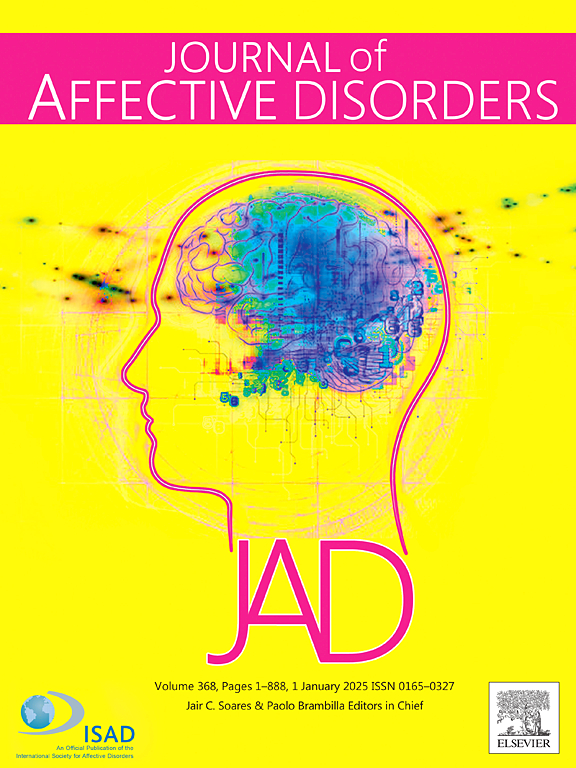KDM3A/BRPF1转录轴对产后抑郁症小鼠模型中铁下沉的表观遗传调控具有神经保护作用
IF 4.9
2区 医学
Q1 CLINICAL NEUROLOGY
引用次数: 0
摘要
产后抑郁症(PPD)是一种衰弱的围产期精神障碍,其发病机制难以捉摸。虽然铁中毒——一种铁依赖性调节的细胞死亡途径——与神经精神疾病有关,但其在PPD中的机制作用仍不明确。方法通过双向孟德尔随机化(MR)方法,对35,559名冰岛人的血源性蛋白数量性状位点(bd-pQTL)进行整合,以确定PPD的致病调节因子。在模拟产后神经内分泌的卵巢切除术/激素戒断小鼠模型中,调解MR描绘了铁中毒相关途径。多模式评估结合了行为表型、铁下垂生物标志物量化、转录谱分析和铁下垂药理学抑制(铁抑素-1)。结果初步MR鉴定出159个铁中毒相关基因,其中BRPF1对PPD具有较强的保护作用(IVW OR = 0.797, P = 0.009)。染色质修饰因子KDM3A调控BRPF1表达(介导β = 0.336, P <;0.0001),形成抑制铁下垂的因果层次。激素戒断小鼠重现PPD神经病理学:抑郁样行为(FST/TST不动↑,OFT/LDT探索↓,P <;0.0001),铁谱特征(海马Fe2+↑,GSH↓,P <;0.001), KDM3A/BRPF1轴抑制(GPX4↓,SLC7A11↓,P <;0.001)。服用他汀-1可挽救行为缺陷,使氧化还原稳态正常化,并恢复KDM3A/ brpf1介导的GPX4/SLC7A11转激活(P <;0.01)。我们建立了一种表观遗传模式,其中KDM3A协调brpf1依赖性的铁凋亡防御(GPX4/SLC7A11)的转录控制,限制PPD的发病机制。这个KDM3A/BRPF1轴代表了一个可药物靶点,铁下垂抑制显示出治疗效果,为新的基于表观遗传的干预提供了信息。本文章由计算机程序翻译,如有差异,请以英文原文为准。
Epigenetic Regulation of Ferroptosis by the KDM3A/BRPF1 Transcriptional Axis Confers Neuroprotection in Postpartum Depression mouse model
Background
Postpartum depression (PPD) represents a debilitating perinatal psychiatric disorder with elusive pathogenesis. While ferroptosis—an iron-dependent regulated cell death pathway—is implicated in neuropsychiatric conditions, its mechanistic role in PPD remains undefined.
Methods
We integrated blood-derived protein quantitative trait loci (bd-pQTL) from 35,559 Icelanders with FerrDb-curated ferroptosis genes through bidirectional Mendelian randomization (MR) to identify causal PPD regulators. Mediation MR delineated ferroptosis-related pathways validated in an ovariectomy/hormone-withdrawal mouse model simulating postpartum neuroendocrinology. Multimodal assessment combined behavioral phenotyping, ferroptotic biomarker quantification, transcriptional profiling, and pharmacological ferroptosis inhibition (Ferrostatin-1).
Results
Primary MR identified 159 ferroptosis-related genes, with BRPF1 exerting robust protection against PPD (IVW OR = 0.797, P = 0.009). Chromatin modifier KDM3A governed BRPF1 expression (mediation β = 0.336, P < 0.0001), forming a causal hierarchy that suppressed ferroptosis. Hormone-withdrawn mice recapitulated PPD neuropathology: depression-like behaviors (FST/TST immobility ↑, OFT/LDT exploration ↓, P < 0.0001), ferroptotic signatures (hippocampal Fe2+↑, GSH↓, P < 0.001), and KDM3A/BRPF1 axis suppression (GPX4↓, SLC7A11↓, P < 0.001). Ferrostatin-1 administration rescued behavioral deficits, normalized redox homeostasis, and restored KDM3A/BRPF1-mediated GPX4/SLC7A11 transactivation (P < 0.01).
Conclusions
We establish an epigenetic paradigm wherein KDM3A orchestrates BRPF1-dependent transcriptional control of ferroptosis defenses (GPX4/SLC7A11), constraining PPD pathogenesis. This KDM3A/BRPF1 axis represents a druggable target, with ferroptosis inhibition demonstrating therapeutic efficacy, informing novel epigenetic-based interventions.
求助全文
通过发布文献求助,成功后即可免费获取论文全文。
去求助
来源期刊

Journal of affective disorders
医学-精神病学
CiteScore
10.90
自引率
6.10%
发文量
1319
审稿时长
9.3 weeks
期刊介绍:
The Journal of Affective Disorders publishes papers concerned with affective disorders in the widest sense: depression, mania, mood spectrum, emotions and personality, anxiety and stress. It is interdisciplinary and aims to bring together different approaches for a diverse readership. Top quality papers will be accepted dealing with any aspect of affective disorders, including neuroimaging, cognitive neurosciences, genetics, molecular biology, experimental and clinical neurosciences, pharmacology, neuroimmunoendocrinology, intervention and treatment trials.
 求助内容:
求助内容: 应助结果提醒方式:
应助结果提醒方式:


